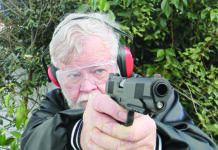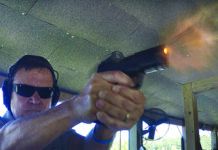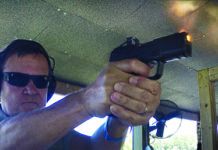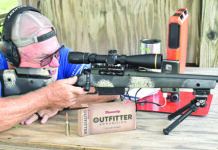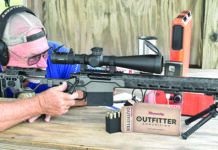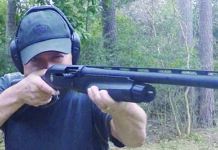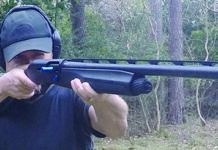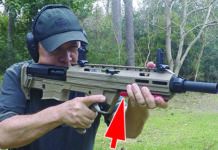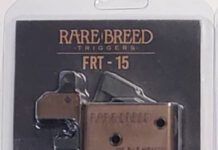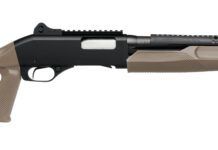The need for a shotgun that can handle 3.5-inch magnum loads appears to be increasing, as more shooters determine they need the maximum load of steel shot they can manage for waterfowl shooting. Gun makers are being sure to chamber their shotgun offerings for the full-length shotshell with its 1 9/16-ounce of steel capability. The prime users of these long-chambered guns seem to be waterfowlers, who forego the 10-gauge guns because, presumably, they want to use their duck guns for other things that the 10 can’t do very well. These uses include upland hunting, casual trap, even Sporting Clays to sharpen the eye in the off season.
The manufacturer’s challenge is to make a gun that can, at least reasonably, handle many tasks including serious waterfowling, and Benelli has stepped up to the line with its newest offering, the 3.5-inch pump Benelli Nova. But the Nova has tough competition in this segment, primarily the old favorite Remington 870 Express, a $400 gun that just keeps on working. To see how the upstart compared to the king of shell shuckers, we got a Nova with RealTree camo and a 26-inch barrel and also purchased a Remington that came as close as we could get to the same configuration, though it had a shorter barrel. Here’s how they did.
Benelli Nova
Our recommendation: The $350 street price of the innovative Nova makes it a bargain in any language. It’s new, it’s nice, it works, we liked it, and we’d buy it.
So many good inventions seem obvious after they come into being; thus it is with the Benelli Nova. One looks at this innovative shotgun’s integral buttstock and action unit—made of plastic—and wants to say, “Why didn’t I think of that!” More to the point, the Benelli Nova system works very well. The necessary metal-to-metal lockup at the breech is achieved by a rotating bolt head that secures itself into locking recesses machined into the barrel extension. The last nearly half-inch of forward travel of the bolt causes the floating bolt head to spin into engagement. The bolt head has two 180-degree-opposed locking lugs that secure the bolt to the breech just like in your bolt-action rifle.
Fit and finish were exceptionally well done throughout this shotgun. The forend, like that of the 870, had a bit of sideplay in the fully locked position. We liked the provisions for sling swivels, one molded into the buttstock, the other underneath the barrel-attaching ring. With a 14.25-inch length of pull and a rounded heel to the buttpad, this gun mounted easily and was long enough to keep your fist off your face when lighting off those steel-filled 3.5-inch roman candles. The gun’s weight kept recoil manageable, and we’ll tell you more about recoil later in this report. The pump-gun enthusiast will find this gun’s controls all very simple and intuitive, except for a button underneath the forend that bears special mention. If you want to unload the gun, you first press that button and HOLD IT DOWN as you work the slide to eject the round in the chamber. The act of pressing and holding the button prevents the next round from being released into the action. We found this to be a bit tricky. It required practice. With the chamber clear, you insert your finger into the loading port and manually release the rounds from the magazine one at a time. The safety was a cross-bolt located right where it belonged, at the front of the trigger guard, where it fell naturally under the extended trigger finger of right-handers. Just in front of that, on the right side, was the bolt release. The release showed a red dot when the bolt was locked fully forward. It also served as a cocking indicator. Loading and unloading the gun were very easy, the magazine accepting three 3.5-inch shells or four 3-inch or 2.75-inch shells. The trigger release was both creepy and heavy. It broke at just over 7 pounds, which is too much, in our view. It needed serious work.
On the good side, the entire trigger group is easily detachable by pulling two pins. The barrel-attaching nut is the tool for this job. It has a button on its nose for starting the pins, and the inside of the nut grips the heads of the pins to pull them out. With the trigger group removed the bolt comes easily away from the twin forend arms. This is a remarkably straightforward design. Reassembly is also very easy. The thick rubber buttpad is removable. This is not for ammo storage, but to accept a recoil-reducing hydraulic device that was already installed when we got the gun. Loaded with magnum 3.5-inch shells, we tested the gun with the device in place and then removed it and fired max loads again, to assess the difference. One of our shooters thought recoil to be far more pleasant with the device removed. Another test shooter could tell no difference with the device in or out, and that was a blind test where he didn’t know if the device was installed. With light loads, however, we could feel a distinct reduction in felt recoil with the device installed. Removing the device brought the empty weight of this gun down to 7.8 pounds. If we owned the gun, we’d organize a lead-filled tube to insert into the buttstock for maximum recoil reduction. Also, we found that greasing the recoil pad and its mating surface in the stock made it much easier to get the pad on and off.
Cosmetically, the RealTree camouflage pattern was well applied, and it was on every visible surface except for the detachable buttpad, the flat black magazine tube, the trigger, and the dull-finished loading gate. We thought the camo finish did a superb job of breaking up the gun’s outline in the Idaho woods. We liked the serrations Benelli put onto this gun at the grasping surfaces. It covered almost all of the forend and pistol-grip surfaces. We thought it looked appropriate for this modern design, and it worked well.
We found a potential sore point with the Benelli’s action. After the round in the chamber has been fired and the slide has been pulled rearward to eject the spent shell, the upcoming round is very loose inside the gun. If you hold the chamber open and hold the gun with the ejection port facing the ground, the fresh round can fall out of the gun. We admit this is not a natural position, but we did have a live round fall out when attempting to cycle the action with the gun pointing nearly straight up…though we couldn’t duplicate this problem afterward. Another thing we didn’t like is that as soon as the chambered round fires, the forend slide is immediately released and the gun immediately opens, whether or not you want it to. This is more of a design feature than a fault, but we prefer to be in control of all functions of our gun at all times. In fairness, you might like this feature, because it makes for very fast field reloading.
The Nova’s patterns were well centered with all loads tested. You get three options for choke with the Nova. They are Full, Modified, and Improved Cylinder. Benelli says you are not supposed to use steel shot with the Full choke tube, but it’s okay with the other two. We suggest you pattern-test your individual gun with your chosen loads. This gun would not be our first choice for upland hunting. It was a bit sluggish for that, and at 7.8 pounds empty (recoil reducer removed) it is too heavy for that purpose, in our estimation. However, it would be right at home in a duck boat or turkey blind. We thought the double beads on the flat-camo finished high ventilated rib made alignment very precise. The weight of the gun was well balanced, and the barrels tracked flying targets well. It was not easy to stop the swing once started. We’d like this gun a lot for waterfowl shooting.
Remington 870 Express Super Magnum Turkey
Our recommendation: Reliability and market acceptance are the keys to this shotgun’s acceptance. For its intended uses, the 870 is still as good as it ever was.
The 3.5-inch Turkey Camo came with a 23-inch barrel, the nearest length we could find to the camo Nova with its 26-inch tube. It’s currently the only camo finish in the 1999 Remington Super Magnum line, being bracketed by the Synthetic Turkey (not our first choice for a gun name), a matte-black model otherwise identical to the Turkey Camo; the Super Magnum, a black metal-and-wood model with a 28-inch barrel; and the Super Magnum Synthetic, an all-black gun with a 26-inch barrel. However, a new model in the Special Purpose line, the Model 870 SPS-T Super Magnum Camo, is virtually identical to the Super Magnum Turkey Camo product, except the SPS-T ships with Extra Full and Super Full turkey chokes.
To our eyes, the RealTree Advantage Camo-finished Super Magnum Turkey 870 could be used in any wing-shooting application, irrespective that it’s positioned as a “turkey” gun. We see a place for this short-barreled gun in grouse coverts or over tight-holding quail cover, because it’s a fast-handling gun. We’re less enamored of it for pass shooting, because it lacks the extra barrel length and weight needed to easily track moving targets, and it also lacks sight radius. The Remington shipped with a Rem Choke Turkey Extra Full extended choke tube, which we supplemented with Hastings flush-fit replacement chokes for most of our head-to-head target-shooting and handling comparisons. With the Turkey choke in place, the gun measured 44.5 inches in overall length. The Remington’s magazine held three 3.5-inch shells, four 3-inch shells or four 2.75-inch shells. The Remington Super Magnum had a busy-looking upland-camo covered synthetic stock and pressed-in checkering. The buttstock had a black rubber recoil pad with black spacer. All exposed metal surfaces including the bolt, trigger guard, part of the slide, and the extended choke tube were finished in matte black. The trigger guard was made of aluminum alloy.
We considered the Remington’s non-reflective camo finish to be well-suited for upland bird, waterfowl, or turkey hunting. We couldn’t find any structural or cosmetic shortcomings, and we noted the metal fit was above average. Most moving parts had only a small amount of play. The forend had a moderate amount of side-to-side play. Weighing 7.25 pounds (a quarter-pound less than Remington’s comparable 28-inch guns) the shorter Super Magnum handled faster than other Remington 870s we’ve tested. Most guns in the line are moderately muzzle heavy; not so with the Turkey model. Swinging and target acquisition were quick and natural, due in part to the gun’s 14-inch length of pull. The gun came to the shooter’s face comfortably, though some of our shooters would have preferred less than 1.5 inches of drop at the comb and 2.5 inches of drop at the heel. The stock didn’t show any cast, which we would have liked. Obviously, Remington set the gun up so that both righties and lefties could use it. Most shooters said the pistol grip was too thin, but it and the forend afforded a secure grasp when the gun bucked with the big 3.5-inch loads. Since the gun is fairly light and since the action doesn’t bleed away any gas, shooters were pounded by the magnum ammunition. Wearing heavy waterfowling or other cold-weather clothing helped immeasurably, and the short LOP still allowed us to get the gun up smoothly. All of the Remington’s controls worked smoothly. A right-handed shooter could disengage the cross-bolt safety at the rear of the trigger guard with his trigger finger, but he had to shift his grip and use his thumb to engage it. Likewise, to reach and depress the action-release lever at the left front of the trigger guard, shooters had to move their firing hands forward. The trigger had a 0.2-inch-wide face with square edges and released cleanly at 5 pounds.
Loaded and ready for ducks, the Remington worked admirably. It fed and fired flawlessly with 2.75-inch, 3-inch and 3.5-inch ammunition we tried. The 870 Super Magnum’s sights consisted of two beads perched on a ventilated barrel rib. The top of the rib was covered in camo, which prevented glare. If we bought this gun, we’d probably remove the beads for wing-shooting work and use some sort of red dot instrument for turkeys. The supplied Extra Full Turkey choke shot very tight patterns, which the gobbler hunter would want, of course. The Hastings Rem Choke-style tubes, suitable for either lead or steel shot, produced acceptable patterns in the Modified and IC constrictions we tried. These tubes are $16.95 from Brownells.
Gun Tests Recommends
Based on a price and performance comparison, the Benelli Nova has stiff competition in the Remington 870 Express Super Magnum Turkey Camo gun, model 5104 in the Remington catalog. This gun, which we bought for $399, has a proven track record of functional durability in the field. While most 870 Wingmaster shooters look down on the less expensive 870 Express line, the Expresses are nonetheless solid products, and are certainly worth $400.
We also liked the Benelli Nova, and believe it’s a lot of shotgun. With a suggested retail price of $425 and a street cost of about $350, it’s going to give even the low-priced Remington Express 870 some rough going. The Benelli gun was well thought out, well made and durable enough. It had plenty of good features, too. We’d buy it over the Remington 870 if for no other reason that everyone else has an 870, and the Nova is both new and nice. We think Benelli is going to sell a lot of Novas, many of them at the expense of the Express.



